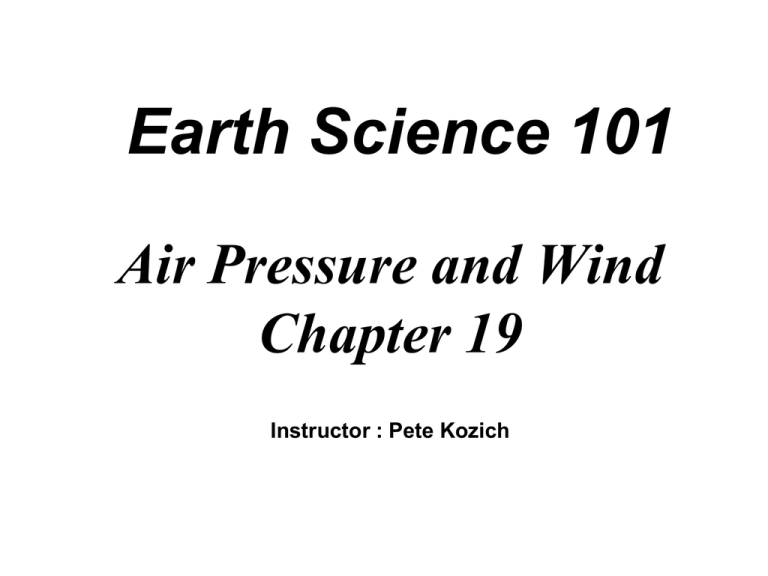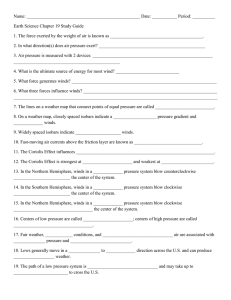CH19two
advertisement

Earth Science 101 Air Pressure and Wind Chapter 19 Instructor : Pete Kozich Atmospheric pressure Force exerted by the weight of the air above Weight of the air at sea level • 14.7 pounds per square inch • 1 kilogram per square centimeter Decreases with increasing altitude Units of measurement • Millibar (mb) – standard sea level pressure is 1013 mb • Inches of mercury – standard sea level pressure is 29.92 inches of mercury Atmospheric pressure Instruments for measuring • Barometer • Mercury barometer • Invented in 1643 • Uses a glass tube filled with mercury and inserted into a mercury filled reservoir • Aneroid barometer • "Without liquid" • Uses an expanding/contracting air chamber • Barograph (continuously records the air pressure) A mercury barometer Figure 18.2 A recording aneroid barometer Figure 18.4 Wind Horizontal movement of air • Results for pressure differences: out of areas of high pressure, into areas of low pressure • Pressure differences are caused by differential heating of the earth’s surface • Solar energy is the driving force. Thermal gradients drive pressure gradients and, from there, the wind. Wind Controls of wind • Pressure gradient force (PGF) • Pressure gradient – pressure change over distance • We measure surface pressures at hundreds of locations across the earth. This data is plotted on a map using isobars. • Isobars – lines of equal air pressure • Closely spaced isobars indicate a steep pressure gradient and high winds • Widely spaced isobars indicate a weak pressure gradient and light winds • The magnitude of the PGF is determined by the spacing of the isobars • The direction it moves is always from higher to lower areas of pressure A weather map showing isobars and wind speed/direction Figure 18.5 Wind Controls of wind • Coriolis effect • An apparent deflection in the wind direction due to Earth's rotation • Deflection is to the right in the Northern Hemisphere and to the left in the Southern Hemisphere • Varies with latitude and wind speed • Maximum deflection at the poles; zero deflection at equator • Deflection increases with increasing wind speed; deflection decreases with decreasing wind speed • Friction • Only important near the surface • Acts to slow the air's movement, also reduces Coriolis • Bends air inward towards low pressure systems The Coriolis effect Figure 18.6 Wind Upper air winds • Generally blow parallel to isobars – called geostrophic winds • Jet stream • Ribbon of air flowing at higher speed, due to regionally enhanced pressure gradient force resulting from strong temperature differences • High altitude • High velocity (120-240) kilometers per hour • West to east direction The geostrophic wind Figure 18.7 Wind Summary • Upper airflow is nearly parallel to the isobars, whereas the effect of friction causes the surface winds to move more slowly and cross the isobars at an angle (towards low pressure). Comparison between upper-level winds and surface winds Figure 18.9 Cyclones and Anticyclones Cyclone • A center of low pressure • Pressure decreases from outer isobars to the center • Winds associated with a cyclone • In the Northern Hemisphere • Inward (convergence) • Counterclockwise • In the Southern Hemisphere • Inward (convergence) • Clockwise • Associated with rising air • Often bring clouds and precipitation Cyclones and anticyclones Anticyclone • A center of high pressure, particularly at low levels • Pressure increases from outer isobars to the center • Winds associated with an anticyclone • In the Northern Hemisphere • Outward (divergence) • Clockwise • In the Southern Hemisphere • Outward (divergence) • Counterclockwise • Associated with subsiding air • Usually bring "fair" weather Cyclonic and anticyclonic winds in the Northern Hemisphere Surface Figure 18.10 Airflow associated with surface cyclones and anticyclones Figure 18.12 General atmospheric circulation Underlying cause is unequal surface heating • Unequal heating creates pressure imbalances • Tropical regions receive more heating than can be radiated back to space • Polar regions receive less radiation than is radiated back to space Idealized global circulation (non-rotating Earth) • Heated air would rise near the equator until it reached the tropopause, which acts as a lid • The air would then deflect poleward • Upon reaching the poles, the air would sink back to the surface, spread out in all directions, and return to the equator • One cell in each hemisphere • Surface air always moves equatorward • Air aloft always moves poleward General atmospheric circulation On the rotating Earth there are three pairs of atmospheric cells (four interfaces) that redistribute the heat Global circulation • Intertropical Convergence Zone (ITCZ) • Rising air • Abundant precipitation • Subtropical high pressure zone • • • • Subsiding, stable, dry air Near 30 degrees latitude Location of great deserts Air traveling equatorward from the subtropical high produces the trade winds • Air traveling poleward from the subtropical high produces the westerly winds General atmospheric circulation Global circulation • Subpolar low pressure zone • Warm and cool winds interact • Polar front – an area of storms • Polar high pressure zone • Cold, subsiding air • Air spreads equatorward and produces polar easterly winds • Polar easterlies collide with the westerlies along the polar front • By far the weakest of the cells; highly variable Global circulation Figure 18.15 Global Atmospheric Circulation Model General atmospheric circulation Influence of continents • Seasonal temperature differences disrupt the • Global pressure patterns • Global wind patterns • Influence is most obvious in the Northern Hemisphere (more land) • Land heats up and cools off more quickly • Mountains change air flow, and land-sea temperature differences influence air flow General atmospheric circulation Influence of continents • Monsoon • Seasonal change in wind direction • Occur over continents • During warm months • Air flows onto land (low pressure) • Warm, moist air from the ocean • Winter months • Air flows off the land (high pressure) • Dry, continental air Average surface pressure and associated winds for January Figure 18.16 A Average surface pressure and associated winds for July Figure 18.16 B Circulation in the mid-latitudes The zone of the westerlies Complex Air flow is interrupted by migrating cyclones and anticyclones • Cells move west to east in the Northern Hemisphere • Create anticyclonic and cyclonic flow patterns • Paths of the cyclones and anticyclones are associated with the upperlevel airflow Upper-level airflow • One of the most obvious features is the seasonal changes • Stronger temperature gradient in the winter corresponds to a stronger flow aloft • Polar jet streams average position migrates south as winter approaches and north as summer approaches in N. Hemisphere Local winds Produced from temperature differences Small scale phenomena Types • Sea breezes • Coastal regions (daytime especially in the summer) • Air over the land heats up creating a low pressure area over land, allows cool air over the water to flow inland • Begins around noon and strongest in late afternoon, often stormy • Land breezes • Coastal regions (nighttime) • Land cools more rapidly than the water creating a low pressure area over the warmer water, allows cool air over the land to flow out to sea • Land/sea breezes can also develop near lakes Illustration of a sea breeze and a land breeze Figure 18.17 Vertical Structure of a Lake/Sea Breeze Local winds Types For mountain and valley breezes, air in contact with the ground heats up and cools off more rapidly over course of a day at higher altitude (lower pressure) • Mountain breezes • Cold air at top of mountain late at night has higher pressure, blows down mountain • Valley breezes • High in mountains, air heats up quickly, lowering air pressure; winds blow up from the valley • Chinook and Santa Ana winds • • • • Near-freezing air passes over a mountain slope and descends Air warms and dries as it descends When it reaches the bottom, it is much warmer Santa Ana winds are an example of a Chinook wind that occurs in Southern California Mountain and Valley Breeze • Flow reverses over the course of the day • This diurnal cycle of winds is best developed in clear summer weather with light winds Chinook Wind • • • • A warm, dry wind Typically descends on the Eastern Slope of the Rockies Also found in Alps Occur when strong westerly winds flow over a N-S oriented mountain range – Forces the air downslope; a trough forms on the east side of the mountains – As the air descends it is compressed and warmed dry adiabatically Fig. 9-33, p. 244 Santa Ana Winds • A warm, dry wind that blows from the east or northeast into Southern CA • The air descends from the desert plateau, funnels through the mountain canyons, and spreads into the LA basin • High pressure develops over the Great Basin and the cw circulation forces the air downslope • Compressional warming, warms the air as it descends • The dry air becomes even drier • Can cause brush fires Satellite Images of CA fires from Earth Observatory Wind measurement Two basic measurements • Direction • Speed (Magnitude) Direction • Winds are labeled from where they originate (e.g., North wind – blows from the north toward the south), reverse of ocean currents • Instrument for measuring wind direction is the wind vane • Points into the wind Wind measurement Direction • Direction indicated by either • Compass points (N, NE, etc.) • Scale of 0º to 360º • Prevailing wind is the time averaged single direction the wind comes out of Speed – often measured with a cup anemometer Wind measurement Changes in wind direction • Meteorologists call them wind shifts • Associated with locations of • Cyclones (especially these) • Anticyclones • Often accompany changes in • Temperature • Moisture conditions El Niño and La Niña El Niño • A countercurrent that flows toward the coasts of Ecuador and Peru • Warm • Usually appears during the Christmas season • Blocks upwelling of colder, nutrient-filled water, and anchovies starve from lack of food • Strongest El Niño events on record occurred during 1982-83 and 1997-98 El Niño and La Niña El Niño • 1997-98 event caused • Heavy rains in Ecuador and Peru • Ferocious storms in California • Related to large-scale atmospheric circulation • Pressure changed between the eastern and western Pacific called the Southern Oscillation • Changes in trade winds creates a major change in the equatorial current system, with warm water flowing eastward • Effects are highly variable depending in part on the temperatures and size of the warm water pools Normal conditions El Niño El Niño and La Niña La Niña • Opposite of El Niño • Triggered by colder than average surface temperatures in the eastern Pacific • Typical La Niña winter • Blows colder than normal air over the Pacific Northwest and northern Great Plains while warmer in the southern tier of the United States • Greater precipitation is expected in the Northwest El Niño and La Niña Global distribution of precipitation Relatively complex pattern Related to global wind and pressure patterns • High pressure regions • • • • Subsiding air Divergent winds Dry conditions e.g., Sahara, Kalahari, Atacama, and MexicanSW US deserts, parts of the Outback Global distribution of precipitation Related to global wind and pressure patterns • Low pressure regions • • • • Ascending air Converging winds Ample precipitation e.g., Amazon, Congo basins and Indonesia Average annual precipitation in millimeters Figure 18.23 Global distribution of precipitation Related to distribution of land and water Colder at poles, less water vapor in air and less precipitation, but also less evaporation • Mountain barriers also alter precipitation patterns • Windward slopes receive abundant rainfall from orographic lifting • Leeward slopes are usually deficient in moisture Seasonal Pressure and Precipitation Patterns End of Chapter 19








